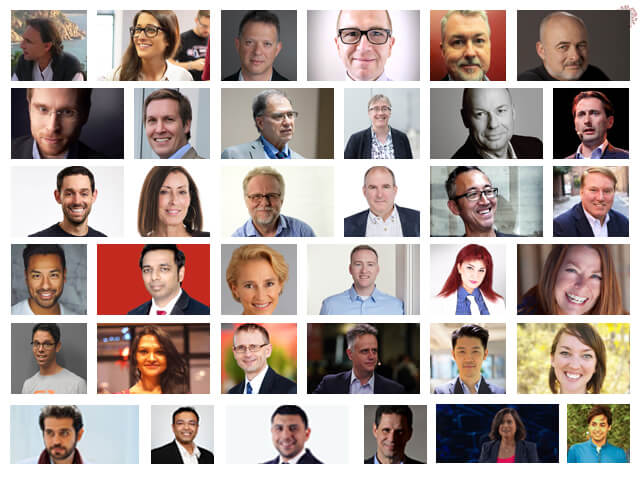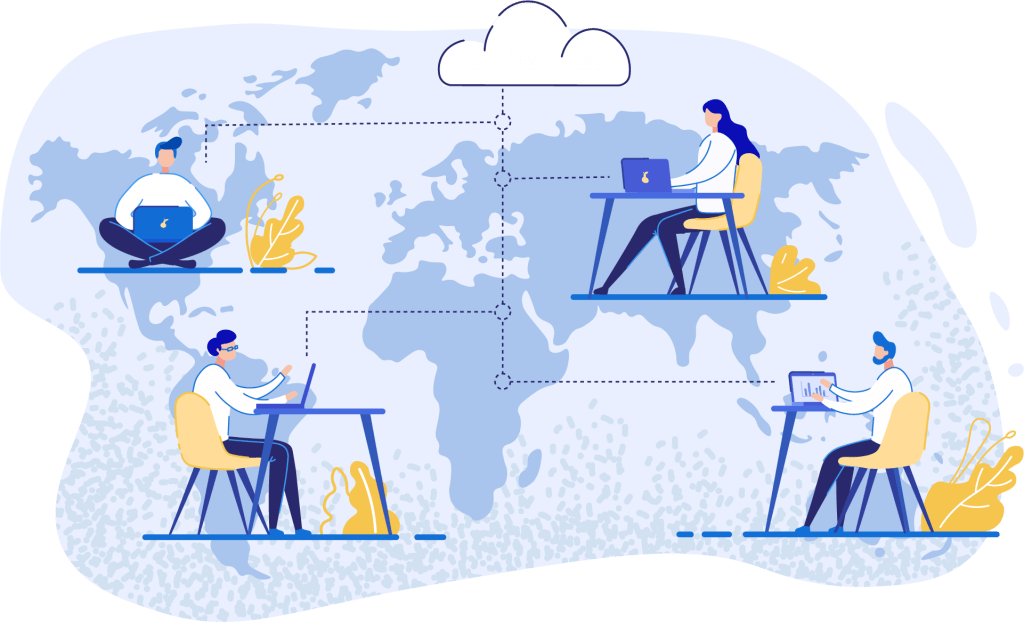

36 Experts Share Digital Workplace Best Practices To Fight COVID-19
The COVID-19 pandemic has become a huge global crisis and is presenting tough choices for organizations and enterprise leaders across the globe. Top virus experts also claim that the vaccine for this lethal virus is at least 12 to 18 months away.
Considering this, it’s safe to say that enterprise leaders should not only prepare for the short term but also explore new capabilities that’ll transform how work gets done in the long term. Organizations across the globe are looking for innovative solutions to manage the unique and complex challenges posed by the pandemic.
With an intention to help enterprise leaders leverage actionable insights to fight this crisis, we’ve asked 36 top digital and technology experts to share their insights on the following question.

Amid the COVID-19 crisis, what is the most critical digital workplace best practice organizations should adopt?

Here’s what they said…
Here’s what they said…

Kirk Borne
– Principal Data Scientist and Data Science Fellow, Booz Allen Hamilton
– (Twitter | Linkedin)
“…A digital workplace best practice is effective digital communications, not only one-way or two-way, but also N-way, that is peer-to-peer…”
A digital workplace best practice is effective digital communications, not only one-way or two-way, but also N-way, that is peer-to-peer. This can be achieved through an information architecture that is effectively a communications network. Critical information should be accessible, searchable, and reusable by employees
This can be accomplished with deep, meaningful search criteria, such as content-relevance ranking indices, semantic labels, content tags, user annotations, and information classification hierarchies (taxonomies and ontologies). This includes user-generated tags, labels, and annotations that encode content, context, use cases, quality, and other information-rich metadata. In this way, communications become a seamless flow of knowledge and content throughout the digital workplace.
“…Transparency for accountability, and cybersecurity cannot be a last minute add on…”
I think there are two very important realisations COVID-19 should have brought to the digital sector:
1. ICT is a means for communication, and as such it does not only need to be used to disrupt. It can also be used to strengthen and improve the institutions that keep all of us alive. This new emphasis on internal communication can help us better understand and identify with our corporations, neighbourhoods, and various levels of government. Even where these are flawed, it can help us better understand, identify, and address any corruption. We need to be able to work together to solve all sorts of challenges, including the pressing ones of the climate crisis and the sustainability goals.
2. Good practices like transparency for accountability, and cybersecurity cannot be a last minute add on. Any tool once created may suddenly experience massive adoption. Every software corporation, however small, needs to follow good practice in ensuring that people can tell exactly who has done what through their software. This includes maintaining the highest standards of cybersecurity, so logs cannot be altered or removed.

Joanna Bryson
– Professor of Ethics and Technology at Hertie School, Reader at University of Bath, International Speaker
– (Twitter | LinkedIn)

David Brin
– Scientist, Futurist Consultant, Science-Fiction Author & Astrophysicist.
– (Twitter | LinkedIn)
“…Expect a real estate boomlet in small scale satellite offices…”
Business meeting ware and work-from-home software – predicted for decades – languished due to managerial reluctance. These will now advance rapidly. But also expect a real estate boomlet in small scale satellite offices, where employees will spend at least part of each day being personally supervised, so their work-at-home hours can be kept effective.
“…Provide generous time and resources for workers to properly adjust and learn important new skills and tools…”
It’s critical that in this time of major disruption, stress, and global change that employers provide generous time and resources for workers to properly adjust and learn important new skills and tools that will help them to be more effective in their newfound situations. This is not just in their role as remote workers, but as functioning and healthy members of newly digital organizations that cannot operate in the same limited ways they did as physical organizations.
1. ICT is a means for communication, and as such it does not only need to be used to disrupt. It can also be used to strengthen and improve the institutions that keep all of us alive. This new emphasis on internal communication can help us better understand and identify with our corporations, neighbourhoods, and various levels of government. Even where these are flawed, it can help us better understand, identify, and address any corruption. We need to be able to work together to solve all sorts of challenges, including the pressing ones of the climate crisis and the sustainability goals.

Jim Harris
– International Bestselling Author & Keynote Speaker on Disruptive Innovation.
– (Twitter | LinkedIn)
“… Engaging employees is critical. Rather than making arbitrary decisions on how to cut costs (for instance) engage employees in the process…”
Engagement, Collaboration & Commitment
During the COVID crisis, engaging employees is critical. Rather than making arbitrary decisions on how to cut costs (for instance) engage employees in the process. You’ll be surprised by the innovative & creative solutions. And people will be committed to the plan because they were the ones who developed it.
Digital Transformation
Organizations that have most aggressively pursued digital transformation – both internally and externally – are thriving. By contrast those stuck in 20th century practices are struggling. The crisis is accelerating digital transformation.
A crisis is a terrible thing to waste. How pivoting your business model and processes?
“… Organisations have to datafy their business processes and customer touchpoints and use analytics, blockchain, AI and other emerging information technologies to make their business more agile, efficient and customer-centric…”
The Coronavirus crisis has many organisations struggling with the new reality. All of a sudden, entire offices had to shift to remote work, although they might not have been ready for it. However, ‘never waste a good crisis’ is a famous saying, and despite these challenging times, it also offers new opportunities for organisations. For years, I have been saying that the organisation of tomorrow is a data organisation.
This means that organisations have to datafy their business processes and customer touchpoints and use analytics, blockchain, AI and other emerging information technologies to make their business more agile, efficient and customer-centric. The current crisis has shown that now, more than ever before, this has become crucial for organisations. After all, organisations with a digital mindset and a data-driven culture will be able to easily switch to a remote-working organisation (if they hadn’t done so already).

Dr Mark van Rijmenam – Founder of Datafloq and Mavin, Speaker and Author, The Organisation of Tomorrow
– (Twitter | LinkedIn)
“…organizations could utilize tools that could change the way we do meetings like using Virtual and Augmented Reality…”
Human interaction is definitely key for communication and building relationships among us. Maintaining the same level of interaction whilst working remotely requires some investments and a change in our mindset too.
Transforming the way we do meetings in my opinion sits on top of the pyramid. We have the basics as Skype, Teams and other collaboration and communication tools.
In the Covid-19 era and beyond, organizations could utilize tools that could change the way we do meetings like using Virtual and Augmented Reality. Hologram yourself into your next team meeting or use a VR kit as if you were sitting with other people in the same room could be the future.
“… Develop best practices on using tools like wikis, agile management tools, and discussion channels to support collaboration and knowledge sharing…”
Organizations must think about collaboration empathy, by which I mean that the types of collaborations that worked in the office may not work at all or as well in the digital workplace. First, organizations need to be sensitive to individual situations around when they can meet, whether they are in a position to enable video sharing, and how to handle unexpected interruptions.
Second, some collaborations that work in physical offices like large brainstorming and coordination meetings may not translate well to virtual meetings. Organizations should also develop best practices on using tools like wikis, agile management tools, and discussion channels to support collaboration and knowledge sharing.

Isaac Sacolick,
President, StarCIO, blogger, and author of Driving Digital – (Twitter | LinkedIn)

Glen Gilmore
– Forbes Top 20 “Social Media Power Influencer”, International speaker & author
– (Twitter | LinkedIn)
“…Chatbots should be used to provide simple answers to the most common questions to minimize delays…”
- Creating an easy-to-use online health and safety resource center so that everyone understands how they can ensure that business will be done while caring for people and safety first.
- Workers should be provided with guidance on the best, secure remote-work tools to use and how to use them
- Chatbots should be used to provide simple answers to the most common questions to minimize delays
- Additional resources should be dedicated to online listening and engagement.
“…Optimize your cyber security by choosing a strong VPN for your professional connexion privacy…”
- Optimize your home collaboration environment by choosing strong tools
- Optimize your cyber security by choosing a strong VPN for your professional connexion privacy.
- To begin, you have to work safely, so I would recommend choosing a collaborative work platform with a well-established reputation, just as the Google G Suite or Office 365.

Pierre Pinna
– Founder and CEO at IPFC Online.
– (Twitter)

Sophie Wade
– Work Futurist, International Keynote Speaker, Founder, Flexcel Network
– (Twitter | LinkedIn)
“… Identifying, defining, and tracking work elements with digital tools allows: management based on forecastable timeframes…”
- Executives and managers breaking their work down into projects and understanding how it flows through the organization
- Identifying, defining, and tracking work elements with digital tools allows: management based on forecastable timeframes
- Tasks to be assigned to employees best-equipped to accomplish that work right now—potentially doing different tasks than before the crisis
- Making adjustments and pivoting as circumstances change and conditions improve
- Recognizing what strategic changes are possible to emerge most successfully in coming months
“…hold virtual workshops to solve specific problems, including brainstorming about new products and services and creating innovative solutions…”
Being on lockdown means remote work has become standard practice, limiting face-to-face interactions with our colleagues and customers. Because much work requires collaboration with many different stakeholders, a primary goal is to ensure we stay connected. Here are a couple of things we are doing at Indigo Slate.
We hold short, daily virtual standup meetings with our team members to ensure we remain a cohesive unit. Also, we utilize our in-house platform, Ruptive, to help us hold virtual workshops to solve specific problems, including brainstorming about new products and services and creating innovative solutions. The bottom line is that, in this time of isolation, we leverage technology to bring all stakeholders together.

Bob E. Hayes
Senior Director of Research and Analytics at Indigo Slate
– (Twitter | LinkedIn)
“… Microsoft 365 enables a safe and collaborative workspace for teams of people to work in real time remotely on the same documents, in the same meetings and through live chat…”
Amidst the COVID 19 health crisis businesses around the world need to resume operations with their employees all working from home. Microsoft 365 enables a safe and collaborative workspace for teams of people to work in real time remotely on the same documents, in the same meetings and through live chat. Taking advantage of Microsoft’s free trial for Teams, partners are able to help customers connect to their employees and resume normal operations.
“…Digital processes and systems should be standardized and well planned in order to get the daily tasks done…”
The first and foremost is to minimize sustained contact with people. Employees don’t have to come to the office and they can work from home. One of the key challenges to remote work is that your employees should be focused on their daily tasks instead of wasting time on posting memes and useless tweets on Twitter. If they do that, then you have a management problem. As a leader of your company you must give them deadlines to perform certain tasks.
Working from home doesn’t mean that they should take it easy. Encourage them to work systematically.
There are many tools which you can communicate with employees during working hours on remote locations such as: facetime, Skype, Facebook video etc
Digitize all the work processes and set a security protocol on user access from remote location.
Security is very important. Set protocols for file sharing. You have to create systems which can be accessed remotely. You should encourage your employees not to share files and documents directly to avoid hackers from hacking your system. It is better to share files via links that require a user to be already in the system in order to get the files. Some companies use VPN or Cloud based solutions to access network’s resources
When it comes to digital collaboration, file sharing systems and web conferencing are great solutions for employees to communicate with each other and collaborate on your company or agency’s tasks
This coronavirus pandemic should not create problems with work processes. Digital processes and systems should be standardized and well planned in order to get the daily tasks done and as a result your company won’t get financial problems in future.

Maria Johnsen
– Global Digital Marketing & AI Influencer, Environmentalist, Investor, Philanthropist & Author.
-(Facebook | LinkedIn)

Jaime Perena,
Director of Marketing and Strategy – Enterprise Artificial Intelligence at Microsoft
“…Business leaders want to refocus AI efforts during and after the crisis…”
Organizations are going back to the drawing board to assess their AI strategy, seeking to manage their AI innovation budgets more effectively.
- Less moonshots
- More risk reduction (shorter time-to-ROI, projects that reduce near-term risks)
More proven ROI
Companies with a “business as usual” approach will be outmatched by firms who have found new ways to drive efficiencies and new ways to serve customers
This crisis can be an opportunity for strategic change. Business leaders want to refocus AI efforts during and after the crisis and are looking for guidance on how.
AI Business School is a master class series designed to help business leaders evaluate how to harness the power of AI for lasting impact in the enterprise
“… Have the right tools in place for employees to be able to communicate, collaborate, and work in a digital environment…”
There are a few things that organizations need to consider during COVID-19. First, is making sure that they have the right tools in place for employees to be able to communicate, collaborate, and work in a digital environment. It’s amazing how many organizations were not prepared or set up to enable this effectively.
As a result so many started to use Zoom only to realize that it had privacy and security issues, now, many organizations banned Zoom from being used at all. This is a classic example of not thinking through digital workplace practices. My wife actually wrote an article for Forbes which aptly summarizes this in the title alone: Is COVID-19 Forcing Your Digital Transformation? 12 Steps To Move Faster.
The second most important practice for organizations to implement isn’t digital in nature but is required to be done digitally now which is human leadership. Leaders around the world must now learn how to inspire, motivate, and engage people that they can’t physically see.
Not only that but during this pandemic they also need to be good human beings and focus on emotional intelligence before business results. This means when getting on a call with a team the conversations should start off with “are you ok?” as opposed to “did you complete that project?” I would heavily prioritize leading virtual teams as a core skill for leaders that is essential for digital workplaces.

Jacob Morgan
– Author, TED and Keynote Speaker, Futurist, and creator of The Future Organization – (Twitter | LinkedIn)
“…We are using MS Teams, Power Apps and SharePoint Intranet for publishing work from home tips, business support conversations, Crisis management apps, health check notifications and more to that end…”
During such a crisis, when every employee is working remotely, keeping them connected with the organization, caring for their well being and creating channels for individuals and teams to communicate is most critical.
We are using MS Teams, Power Apps and SharePoint Intranet for publishing work from home tips, business support conversations, Crisis management apps, health check notifications and more to that end.
“…Enhance the employee experience by providing tools and working methods that help the remote worker adapting to the new digital workplace…”
The current COVID-19 pandemic poses not only health-related questions and challenges but also a paradigm shift in our way of living and relating to others. Companies cannot afford to suspend operations and wait for returning to normality. Business must continue!
The Digital Transformation can help us not only as a way for business improvement but above all as a new model of life.
Many firms are proposing technologies that empower agile work. However, technology isn’t the only enabling element. We must promote strategies and good practices to guarantee the health and safety of workers and at the same time assure the security and protection of data and information.
Here are a few:
Develop soft skills related to flexibility, agility and adaptability.
- Improve time and autonomy management as well as the responsible attitude.
- Enhance the employee experience by providing tools and working methods that help the remote worker adapting to the new digital workplace.
- Promote the collaboration capabilities and a results-oriented corporate culture
- Empathize with team members.
- Implement a strong security policy to guarantee data privacy and ensure protection from cyber threats.
“…It’s more important than ever during this time to be flexible, patient, and accountable…”
COVID-19 is challenging many of us in new ways. Some of us have new “co-workers” at home. Some of us have to create a new environment at home that supports working and living at the same time. And many of us may feel suddenly cut off from others. It’s more important than ever during this time to be flexible, patient, and accountable. It’s very important to remember, in the midst of all of this, to care for yourself. You need to be at your best to fully support your family, friends, coworkers and the community around you.
“…Create crisis management teams in the enterprise, who can develop organizational strategies, policies, protocols, and frameworks for the hygiene practices…”
It’s critical to create crisis management teams in the enterprise, who can develop organizational strategies, policies, protocols, and frameworks for the hygiene practices. Craft presentations with Covid-19 dashboards for awareness of social distancing and prevention of the coronavirus within the organization. Enable video and audio capabilities for teams to work on the projects without disruptions. Providing travel/international (SOS) advisory services is another aspect for mission-critical client needs such as supporting infrastructure.
“…Leaders and managers can help mitigate, even in small ways, the stress this is placing on their teams by being empathic to their situations…”
While a shift to digital, whether it’s related to sales, collaboration with employees, customers, and prospects, marketing, or otherwise is of course critically important, what I think is most important is focusing on culture. For some employees, a shift to WFH and digital collaboration is no big deal, but for others, especially those jugging family responsibilities at the same time, this is a very big, very disruptive shift.
Leaders and managers can help mitigate, even in small ways, the stress this is placing on their teams by being empathic to their situations, checking in regularly, both 1:1 and in group conversations, and not talking about work but instead talking about life, their families, their mental health, and what, if anything, the organization and its leaders can do to help make this shift easier.
The great companies among us generally owe their success and reputations to just two things: Their employees and the culture they’ve invested in creating. So now, while business is important, your people are even more important
Remembering, and acting upon that, is top of the list for best workplace practices, now more than ever.

Shelly Kramer
– Senior Analyst + Partner | Futurum Research
– (Twitter | LinkedIn)

Dr. Robin Kiera,
CEO, Insurance Influencer & Founder of Digitalscouting
– (Twitter | LinkedIn)
“…Regularly share your thoughts on the goals and strategy of the company…”
Inspire your team – daily. As a leader leveraging a digital workspace during a crisis it’s urgent to regularly share your thoughts on the goals and strategy of the company and what you expect from each and every team member in the company – may it be 10 or 10.000 people. Only when the team knows WHY WE as a company DO things, they can take that as guidance for their very own work. In order to manage this, we urge all our clients to organize high performing task forces and get inspiration from outside their organization.
“…Have a way to share news with the whole team, not just with individuals.…”
Take the time to ask how people are doing before getting down to business. This sounds counterintuitive but there are two reasons for this:
It is unfair (and counterproductive) to ask people to do tasks that require their full attention if people are under stress because of family or other real-world situations.
Employees will remember leaders and organizations that seem to care when this is all over.
Offer an outlet for humor, fun and sharing. At the Kevin Eikenberry Group, we have a Slack channel we call the #watercooler. It’s for family news, posting memes (sometimes gallows humor) and other things that won’t clog up work channels but help us stay in touch and connect with each other personally.
Have a way to share news with the whole team, not just with individuals. Nobody wants to be “the last to hear” something. In addition, people want to hear good news so rather than give positive feedback just to the person involved, share it with the team. Use a variety of methods including meetings, emails, instant messages and video.

Wayne Turmel
– CoFounder & Product Line Manager, Remote Leadership Institute
– (Twitter | LinkedIn)
“…Create intentional communication agreements…”
Connect on purpose. Virtually, people don’t have accidental conversations that bring clarity to teamwork and depth to relationships. Teams must create intentional communication agreements. First, who needs to communicate with whom about what, and who else needs to be involved? Answer regarding the work, especially since workflows may need to change in the digital workplace.
Second, get to know team members to better support them. Isolation and loneliness when working virtually is real, so it’s critical to actively expand emotional bandwidth.
“…The new work-design and culture requires lean communication and transparency. Nothing breaks silos better than digital technologies…”
Well, to be honest this ‘New-Normal’ was long impending. Much as we regret the cause for this sudden paradigm shift, Future-of-work had prepared us almost a decade back for it. Identifying a result oriented work-flow is the key. This is where digital transformation plays the biggest role. The new work-design and culture requires lean communication and transparency. Nothing breaks silos better than Digital technologies. Hence, using this technology to build transparency and speed will remain the best practice.
Staying focussed on efficiency as the quarantine ends will hold the key. Hence measuring work with results will continue. This new-normal has created a level-playing field. This is the first time, when talent has been non-gendered and geographies are immaterial as everyone is seamlessly working from home. Hope this opens up greater avenues for growth and opportunities for both business and talent !

Timothy Hughes
– Co-Founder & CEO – Digital Leadership Associates, Speaker, Innovator & Best Selling Author.
– (Twitter | LinkedIn)
“…The only way you can now prospect, build relationships (there being no face-to-face meetings) to enable you to move sales through to close is via social media…”
We are already in a “new normal”. The days of creating leads through conferences and events is over. Cold calling doesn’t work as you are calling empty offices or staff that have been furloughed. How many times can you realistically email somebody? Not very many. The use of advertising has fallen through the floor as people take to use social media. The use of social media has doubled.
The only way you can now prospect, build relationships (there being no face-to-face meetings) to enable you to move sales through to close is via social media. Companies must double down and invest in their staff so companies are stronger and fitter for the Covid-19 exit strategy.
“…the more business as usual you can operate as the more positive you will come out of this situation…”
Whilst what we are all dealing with is unprecedented, there will be an end to this when businesses will need to continue and focus on any recovery needed. What we need to be conscious of during this time is our customer will still be a potential customer at the end of this and recognising this and behaving appropriately now will determine the long term effect on our brand. Right now the more business as usual you can operate as the more positive you will come out of this situation.
It may be that you cannot solve a customer’s need as per normal, for example cannot put an engineer on site to help them, but being contactable and engaging is a big part of the customer experience right now.
Empowering your staff to be able to take calls, speak with clients and access the systems they need, will not only benefit customers, but will also give your staff some feel of normality and keep them engaged and confident for your business whilst we process through this pandemic. Social Distancing Shouldn’t Mean Customer Distancing!

Bill Mew
– Founder and CEO, CrisisTeam
– (Twitter | LinkedIn)
“…Enterprises need to learn to be more risk-aware – and cybercrime is probably the most concerning risk on the horizon right now…”
While the recent deluge of tips about how to work from home and how to remain secure, have been very helpful. The real lesson to be learned from the pandemic is about risk and crisis preparedness.
Those who failed to appreciate the credit risk ahead of the 2008 financial crisis or failed to appreciate the health risk ahead of the 2020 pandemic, have been the worst hit. There is more change in the competitive landscape during a crisis than at any other time – just as Lehman Bros and others collapsed in the financial crisis, others with better crisis preparedness emerged to take the lead. Many more firms will fail during the current pandemic, but again rivals that are better prepared will rise to capture the market instead.
Enterprises need to learn to be more risk-aware – and cybercrime is probably the most concerning risk on the horizon right now – and they also need to focus on crisis preparedness, which is not only emerging as a source of competitive advantage, it is also the best chance you will have of overtaking all your competitors and capturing a leading position in the market. Be prepared and you will thrive, while all around you fail.
“…remote open space, a format which is truly inclusive and invites everyone’s participation…”
At eyeo, we’ve recently organized a remote open space, a format which is truly inclusive and invites everyone’s participation. And despite what you may think, it’s something that can be held remotely too. Juggling time zones from Hawaii to Indonesia and finding remote collaboration tools that could handle an entire company were just a few factors that made the event complex. But fun? Definitely. And we’ll certainly be doing it all again. Here’s what our best practices in organizing our remote open space were.

Tim Schumacher
– Entrepreneur and Investor, Co-Founder and Chairman – eyeo – (Twitter | LinkedIn)

Laurel Farrer
– Remote Work Expert, CEO and Founder, Distribute Consulting
– (Twitter | LinkedIn)
“…The responsibility of controlling results should be given to the employee…”
My hope is that more business leaders will stop relying on tools and software to foster employee productivity and engagement. Instead, the responsibility of controlling results should be given to the employee.
Effective self-management is a combination of soft skills like proactivity, communication, empathy, discipline, critical thinking, and intrinsic motivation. By providing training and support for this type of autonomy, businesses will reap the best results that the strategy of remote work has to offer.
“…Organizations must come up with a policy that covers ways to collaborate and communicate so as to streamline day to day activities without causing burnout…“
Set up work from home policy focusing on collaboration and communication. With everyone working from home all of a sudden, lack of communication and collaboration can create a chaotic situation.
Organizations must come up with a policy that covers ways to collaborate and communicate so as to streamline day to day activities without causing burnout
There are many communication tools like Basecamp, Slack, Wiki which can be used at company as well as team level.
Also online collaboration is important when the team is not working in the same office. Google docs, Notion and project management tools like Trello, Asana and ZOHO Projects help in fast, easy and clear collaboration.

Liam McIvor Martin
– Co-Founder, TimeDoctor – (Twitter | LinkedIn)

Stephen Warley
– Founder, LifeSkillsThatMatter
– (Twitter | LinkedIn)
“…identify and celebrate what makes them (team members) uniquely productive…”
Manage Your Energy, Not Your Time
I’m hopeful organizations will encourage their team members to identify and celebrate what makes them uniquely productive, instead of submitting to a “one-size-fits-all” productivity ideal. The more each of us can work in alignment with our natural rhythms, the more productive organizations can become!
For example, you may be awake for 16 hours a day, but not every hour is equal in terms of your available energy! Start paying attention to your “peak performance period”. What 3 to 4-hour block of time do you feel like you have the most energy and sharpest mental focus? It’s different for everyone!
Reserve this special energy for your MOST important work. The work that will have the greatest impact in terms of moving toward your goals. Your peak performance period is the foundation of designing a productive workday. Learn more about identifying your peak performance period here.
“…For organizations to thrive in a digital workplace, especially in this new territory of remote work, the most important thing organizations should focus on is company culture…”
For organizations to thrive in a digital workplace, especially in this new territory of remote work, the most important thing organizations should focus on is company culture. Management and leadership teams need to step up now more than ever and take responsibility for setting their teams up for success. They need to trust they’ve hired the right people and give those employees the opportunity to step up, or rather into this new norm. This requires open communication, a willingness to find creative solutions, and embracing the hiccups throughout the learning process. COVID-19 isn’t an excuse for a problem, it’s an opportunity for creative solutions

Kate Smith
– Founder of The Remote Nomad – (Twitter | LinkedIn)
“…use this opportunity to drive digital change in your organization to survive and adapt in the new normal…”
The most important is to use this opportunity to drive digital change in your organization to survive and adapt in the new normal. Even if COVID finishes, the chances of recession are high, digitize your company to stay lean in this critical period.
“…Show empathy and have real conversations about things like the circle of company operations also keeping your customers operating in turn…”
Be human. In this time of need, your humanity is something that needs to be brought to the forefront of your strategy. Whether that is to your employees, customers, or even to complete strangers not associated with your business– it’s time to shine and show a little bit of that corporate responsibility. People are watching what their favorite brands do to stand out and join the good fight. We all have to make lemonade out of lemons at this point, and how you do this will really show your customers what you’re made of. Make sure it’s something good.
Find ways to keep your team motivated. Media drama and anxieties arising from family related issues make it extremely difficult for everyone, including management, to not be distracted and disheartened by current events. This causes cognitive dissonance among your employees, affecting mental health, morale, and efficiency. Remote work is already isolating, and with stay-at-home orders, your employees are separated from their typical social outlets. Show empathy and have real conversations about things like the circle of company operations also keeping your customers operating in turn. Everyone needs a reason to get up in the morning and get to work, particularly now. Give them one.

Shawn Pillar
Direct of Marketing, Juicer.io
We're all in this together!
We’d like to take a moment and sincerely appreciate all the experts who’ve shared their thoughts and experiences. Hope you found these insights helpful and unveiled new ways to fight this crisis.
As the majority of the workforce across the globe have transitioned to remote working, a quick crisis management tool kit to address the changing dynamics is the need of the hour. Adopting modern digital workplace solutions, best practices and a digital-driven culture has become imperative for organizations. Digital workplace technologies are helping organizations protect their employees, limit productivity losses and improve collaboration whilst ensuring security.
Looking for further insights regarding this topic? Here are few compelling thought leadership articles spinning around fighting the global pandemic.

Insights












